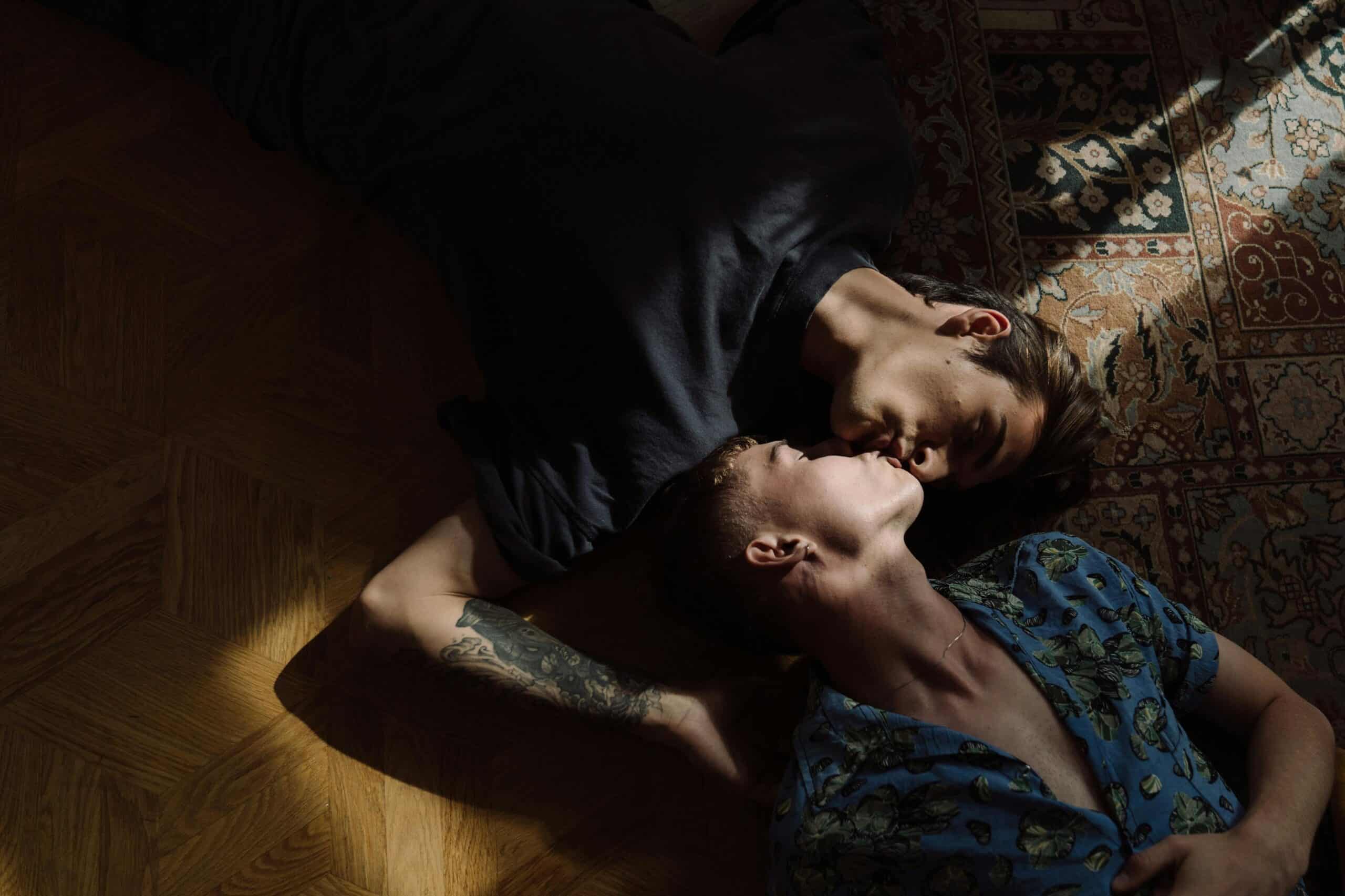
Most queer folks have probably heard the “U-Haul” joke, right? You know, the one where lesbians supposedly move in together after just a couple of dates. By now, it’s been used so much that it’s less about getting a laugh and more about triggering an eye-roll. But somehow, it’s still kicking around. So, Taimi’s research team decided to dive into this myth to see what’s really going on.

Turns out, a lot of lesbians weren’t even aware of the U-Haul stereotype! And by a lot we mean 54.31% which is over half. For those who have heard of it, 48.39% say it’s kind of true, but definitely exaggerated.

So, what does the data actually say about U-Haul relationships among lesbians? And more importantly, how does this tie into emotional needs, identity, and psychology when it comes to lesbian dating? Let’s dig into this a little deeper, shall we?
U-Haul’s Origin Story
The joke, “What do lesbians bring on a second date? A U-Haul!” is almost 40 years old, it was first coined by actor and comedian Lea DeLaria in her stand-up act back in 1989. Some people argue that jokes like this are harmful. They paint an entire group of people as if they’re all the same, and in this case, they suggest lesbians are just a little too eager, or even compulsive.
But here’s the thing: these “stereotypes” aren’t always as bad as they seem. In fact, they often reflect a shared, self-deprecating sense of humor. When you’re part of a marginalized community, humor can be a way to bond, cope, and even fight back. It’s a survival tactic, really, laughing together when the world laughs at you.
What the Data Really Says About U-Haul Lesbians
Taimi’s research data might be from a small sample size, but it still shows something interesting: lesbians tend to move in together a bit faster than the average couple. It’s not wildly fast, but there’s definitely a trend.

28.48% said after 1-3 months they entered a serious relationship which compared the other factions of the community is a higher than average number.
And there’s more. Lesbians also have some other key milestones they consider when a relationship gets serious. The top of that list? 65.13% say meeting the family is the top milestone to define a ‘serious relationship’

So even if lesbians aren’t necessarily moving in together way faster, that doesn’t mean they’re not jumping into deeper connections quicker than other groups. Here’s what that might look like:
- Introducing new partners to your friend group earlier
- Spending the night at each other’s places and leaving your stuff there
- Early family introductions
- Making big purchases together (we’re talking joint gifts, major investments)
- Going on vacations together
And then there’s that whole “lesbians move in too fast” stereotype, which ties into another one: the idea that lesbians stay friends after breakups and keep their social/dating circles really close-knit. It’s kind of like everyone in the community knows each other, or at least knows someone who knows someone.
How Attachment Styles Influence Lesbian Cohabitation And Commitment
Attachment styles are basically the blueprint for how we form bonds with others and handle relationships. There are four main types of attachment styles:
- Secure
- Anxious
- Avoidant
- Disorganized
We develop our attachment styles mostly based on our relationship with our caregivers growing up. But other stuff can affect it too, like family rejection, loss of community, or even trauma in our younger years. These things can lead to developing a less-than-healthy attachment style.
Queer women, in particular, are more likely to face these struggles, which means they’re at a higher risk for developing insecure attachment styles. So let’s dive into how each attachment style might influence whether or not you move in too fast or take other big steps in your relationship.
Is Your Attachment Style Making You Move Too Quickly?
Just to be clear, being a lesbian doesn’t automatically mean you have an insecure attachment style. But since marginalized groups face more trauma and rejection, it’s worth considering how these experiences might shape how we form attachments and navigate relationships.
Anxious Attachment Style
If you have an anxious attachment style, you probably struggle with a negative self-image but tend to put your partner on a pedestal. You’re constantly worried about losing their affection or approval, and that fear of abandonment can make you rush into things. This could mean moving in too soon, or even pressuring your partner to take that step before you’re both ready.
Avoidant-Dismissive Style
Avoidant-dismissive people like their independence and tend to steer clear of emotional intimacy. They often treat relationships like liabilities rather than something to invest in. If you have this attachment style, you’re probably not rushing to move in with anyone. You’ll likely take your sweet time before committing.
However, if an anxious partner pressures you to move in, or if you have to for practical reasons, it can get messy. You might feel resentful or pressured, which can lead to toxic behavior, like picking fights or pushing your partner away.
Disorganized Style
This one’s a mix of both anxious and avoidant. People with this style can go from overly fawning to suddenly becoming distant and uninterested, which can leave the other person feeling totally confused and hurt.
When someone with a disorganized attachment style commits quickly, they often regret it later. If you cohabitate too soon, the emotional rollercoaster might make it hard to navigate your feelings, especially when things get hot and cold.
Community and Safety – It’s Not Just About Romance
You’ve probably heard of “minority stress theory” before, but if not, here’s the gist: people in marginalized communities deal with extra stress because of discrimination and stigma. This stress isn’t just a mental thing, it can lead to physical and emotional issues too. Many of these stressors are shared across various minority groups, like prejudice, fear of violence, and straight-up discrimination. But for queer folks, there’s also the unique stress of internalized homophobia or having to hide who you are.
When you add trauma, marginalization, and discrimination to the mix, it makes sense that lesbian relationships might look a little different. For some, early cohabitation or jumping into commitment could be a way to find safety and emotional validation, especially after coming out and facing all those struggles. It’s not just about rushing into romance; it’s about seeking a safe space to exist and be loved without fear.
Queer women, particularly, date within tight-knit communities and have smaller social circles, which can actually foster a sense of trust. There’s something powerful about knowing that the people around you understand the journey you’re on.
A Funny Meme, A Complex Evolution
Okay, let’s be real: the U-Haul meme is kind of funny, but also, let’s be honest, it’s a little outdated. But it’s not just about leaning into that classic stereotype. It also points to something way deeper, the evolution of sapphic relationships. The whole joke touches on real-world stuff like activist movements, history, bias, and how queer folks have had to build family bonds outside of the traditional, heteronormative structures.
Taimi’s research shows that the whole “U-Haul” stereotype isn’t as real or relevant as many think. While some lesbian couples do move in together a little faster than heterosexual couples, this isn’t a universal experience. The data reveals that many lesbians prioritize emotional milestones, like saying “I love you” or becoming exclusive, over moving in with a partner.
Here’s the main takeaway: lesbian relationships don’t necessarily move faster than other relationships. The idea that we’re all rushing to live together is more of a myth than reality. Instead, lesbians focus on deep emotional connections, and moving in together doesn’t even make the top three relationship milestones; meeting the family takes first place, followed by exclusivity and confessing love.
So, while the “U-Haul” joke might still be funny, it doesn’t quite line up with what’s really happening in lesbian dating in 2025.





